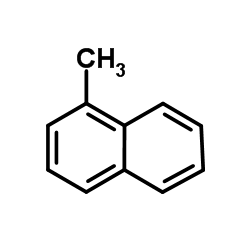1-甲基萘
一般危化品

1-甲基萘结构式
|
常用名 | 1-甲基萘 | 英文名 | 1-Methylnaphthalene |
|---|---|---|---|---|
| CAS号 | 90-12-0 | 分子量 | 142.197 | |
| 密度 | 1.0±0.1 g/cm3 | 沸点 | 242.8±3.0 °C at 760 mmHg | |
| 分子式 | C11H10 | 熔点 | -22ºC | |
| MSDS | 中文版 美版 | 闪点 | 82.2±0.0 °C | |
| 符号 |


GHS07, GHS09 |
信号词 | Warning |
|
QSPR modeling of octanol/water partition coefficient for vitamins by optimal descriptors calculated with SMILES.
Eur. J. Med. Chem. 43 , 714-40, (2008) Simplified molecular input line entry system (SMILES) has been utilized in constructing quantitative structure-property relationships (QSPR) for octanol/water partition coefficient of vitamins and organic compounds of different classes by optimal descriptors.... |
|
|
Optimization of a large-volume injection method for compound-specific isotope analysis of polycyclic aromatic compounds at trace concentrations.
Rapid Commun. Mass Spectrom. 29 , 2349-60, (2015) Compound-specific isotope analysis (CSIA) of persistent organic contaminants can be used for source apportioning in the environment if appropriate sensitivity can be achieved. This paper describes the optimization and validation of a sensitive analytical appr... |
|
|
Influence of solvent, electron acceptors and arenes on photochemical decarboxylation of free carboxylic acids via single electron transfer (SET).
Molecules 15(4) , 2623-30, (2010) Single electron transfer (SET)-photochemical decarboxylation of free carboxylic acids was performed in a polar solvent using several arenes such as phenanthrene, naphthalene, 1-methylnaphthalene, biphenyl, triphenylene, and chrysene in the presence of various... |
|
|
Determination of descriptors for polycyclic aromatic hydrocarbons and related compounds by chromatographic methods and liquid-liquid partition in totally organic biphasic systems.
J. Chromatogr. A. 1361 , 240-54, (2014) Retention factors on several columns and at various temperatures using gas chromatography and from reversed-phase liquid chromatography on a SunFire C18 column with various mobile phase compositions containing acetonitrile, methanol and tetrahydrofuran as str... |
|
|
Quantitative structure-activity relationship analysis of inhibitors of the nicotine metabolizing CYP2A6 enzyme.
J. Med. Chem. 48 , 440-9, (2005) The purpose of this study was to develop screening and in silico modeling methods to obtain accurate information on the active center of CYP2A6, a nicotine oxidizing enzyme. The inhibitory potencies of 26 naphthalene and 16 non-naphthalene derivatives were de... |
|
|
Exploring QSAR and QAAR for inhibitors of cytochrome P450 2A6 and 2A5 enzymes using GFA and G/PLS techniques
Eur. J. Med. Chem. 44 , 1941-51, (2009) A series of naphthalene and non-naphthalene derivatives ( n = 42) having cytochrome P450 2A6 and 2A5 inhibitory activities, reported by Rahnasto et al., were subjected to QSAR and QAAR studies. The analyses were performed using electronic, spatial, shape and ... |
|
|
Predictive three-dimensional quantitative structure-activity relationship of cytochrome P450 1A2 inhibitors.
J. Med. Chem. 48 , 3808-15, (2005) The purpose of this study was to determine the cytochrome P450 1A2 (CYP1A2) inhibition potencies of structurally diverse compounds to create a comprehensive three-dimensional quantitative structure-activity relationship (3D-QSAR) model of CYP1A2 inhibitors an... |
|
|
Ralstonia sp. U2 naphthalene dioxygenase and Comamonas sp. JS765 nitrobenzene dioxygenase show differences in activity towards methylated naphthalenes.
J. Biosci. Bioeng. 113(2) , 173-8, (2012) Methylsubstituted naphthalenes constitute a significant part of light gas oil fractions (LGO). These are toxic compounds with low fuel value, and can potentially be enzymatically modified to increase the fuel value and at the same time reduce toxicity. The fi... |
|
|
An aqueous concentration model for riverine spills
J. Hazard. Mater. 64(1) , 37-53, (1999) A numerical model is developed to predict the aqueous concentrations of sparingly soluble compounds resulting from oil, fuel, or chemical spills onto rivers. The model computes the concentration of compounds both in the slick phase and in the aqueous phase by... |
|
|
Screening for petrochemical contamination in seafood by headspace solid-phase microextraction gas chromatography-mass spectrometry.
Anal. Bioanal. Chem 407 , 4079-90, (2015) A headspace solid-phase microextraction gas chromatography-mass spectrometry (SPME GC-MS) method is described, to screen seafood for volatile organic compounds (VOCs) associated with petrochemical taint. VOCs are extracted from the headspace of heated sample ... |